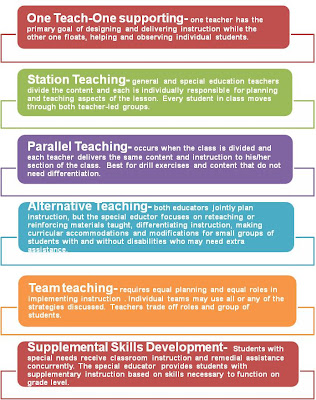We understand that these are sad realities within our school but the hard fact is that inclusion is not a thing in the past. It is here and it looks like it is here to stay. The information below show us how general educators are playing active roles in special education
We need to start setting aside personal differences and focus on what is important: TO EDUCATE ALL OUR CHILDREN.
Here are suggestion to a successful regular and special education partnership by the Council For Exceptional Children (CEC):
1. Be flexible.
2. Get to know your co-teacher's style, classroom procedures, strengths and needs. Understand and respect the content or subject matter expertise that other teachers have. Their knowledge can greatly complement your work. Use this to your students' advantage.
3. Accentuate the positive: Tell each other what is being done well and why it works. Remember to say. "Thank you" and reciprocate any complements.
4. Remember that everyone has the same goal; to help children learn.
5. The relationship must be built on mutual respect for each other's expertise-together you can help all your students.
6. Both of you should work together on a common goal for the students.
7. Both of you should be willing to share responsibility and accountability for achieving those goals.
8. Do not hesitate to ask for assistance and resources, it is the specialists and your administrators responsibility to make sure you have all the support you need. Do not be afraid to ask questions about matters that is unknown to you, the unknown can be frightening . Knowledge can make you become more comfortable to effectively teach your students with exceptionalities.
9. Do not think that collaboration is one-size-fits-all. There are a number of collaborative approaches that you and your team can explore until you find the approach that is most effective.
Marilyn Friend and Lynne Cook (1996) described collaborative approaches to coteaching:
Paraprofessionals in the Classroom
The paraprofessional provides the special education teacher with assistance in providing academic, emotional, and social needs of special education
students. Under general supervision, the paraprofessional provides the classroom teacher with assistance in providing for the physical and
instructional needs of special education students as outlined in the Job Description of the Prince George’s County Public Schools.
POSITION DESCRIPTIONS
Duties/Responsibilities:
• Monitors arrival and dismissal of students assuring that they get to correct classrooms;
• Performs tasks such as taking attendance, bus duty, lunch duty, recess duty, upkeep of bulletin boards, and checking homework and forms
going home;
• Keeps data, point sheets, and anecdotal records or students’ behavior and performance;
• Assists students at lunch to assure that they eat properly and clean up afterwards (this may include feeding the student);
• Assists students with personal care needs in the bathroom, when they are ill or physically uncomfortable; and with physical needs, such as
lifting, positioning in various equipment, adjusting and pushing wheelchairs, etc.;
• Assists teacher and students with audio-visual equipment;
• Assists students with their assistive technology and communication devices, both low and high tech, including basic sign language;
• Reinforces the pre-academic, academic and functional academic subjects, and functional skills being taught; assists in the preparation of
instructional materials, (e.g., copying, cutting out, laminating, etc.); may assist with classroom coverage when necessary;
• Accompanies students to classes such as motor development and music, to assist the teacher, as needed;
• Accompanies students to special classes such as homeroom, physical education, music, art, electives, or assemblies to facilitate inclusion;
• Works with students, teachers, and other professional personnel in carrying out the various special education programs at early childhood,
elementary, and secondary levels; and
• Never leaves students unattended in the classroom.
HOW TO WORK MORE EFFECTIVELY WITH YOUR PARAPROFESSIONAL
1. Familiarize the paraprofessional on all safety procedures and legal issues in working with students with special needs.
2. Determine your working style and preferences.
3. Determine your paraprofessional’s working style and preferences.
4. Share and discuss your working style and preferences5. Determine the needs of the students and tasks required to meet those needs.
6. Assess the skills of your paraprofessional.
7. Create a working plan for the paraprofessional.
8. Train the paraprofessional on assigned duties.
9. Observe and give feedback on assigned duties, and continue to coach on new skills as needed.
10. Provide a written plan for paraprofessionals.
11. Provide time to meet regularly.
12. Design and implement a daily routine for the class, together.
13. Maintain open communication to promote collaboration.
PARAPROFESSIONALS: HOW TO WORK MORE EFFECTIVELY WITH YOUR TEACHER
1. Familiarize yourself with safety procedures and legal issues in working with students with special needs.
2. Determine your working style and preferences and share them with your teacher.
3. Determine your teacher’s working style and preferences.
4. Determine your strengths and weaknesses, and share them with your teacher.
5. Familiarize yourself with the classroom routine and duties.
6. Familiarize yourself with the needs of each student, and how to meet those needs as assigned by the teacher.
7. Ask for feedback from your teacher on new skills or unfamiliar duties.
8. Meet regularly with your teacher.
9. Maintain open communication to promote collaboration.
***** Just a reminder, no child should ever be left unattended. *****
Information from:
Extensions to Curriculum Framework Progress Guide for Special Populations-Reading/English Language Arts-Grade K-5
Prince George’s County Public Schools


